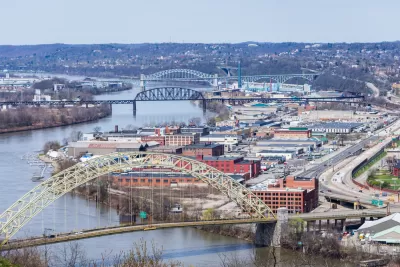To prevent losing funding if the state's interstate highways fall below new federal standards, Pennsylvania is rushing to change its capital investments plans.

"The Pennsylvania Department of Transportation will shift $3.15 billion from local road projects to improvements on the interstate highways over the next nine years," reports Ed Blazina.
"For years, the state has delayed major maintenance work on the state’s interstate highway system while officials waited for an expected influx of federal funds," to explain the reason for the shift. "But now, with no federal money on the horizon and road conditions reaching the point where federal officials could cut existing federal funds because of the state of road conditions, Pennsylvania decided to shift its emphasis to the interstate system."
"The change, approved by the Federal Highway Administration in June, begins this year by taking $150 million statewide from local projects and earmarking the money for interstate work. That will increase by $50 million a year until 2028, when it reaches $3.15 billion."
The article includes a lot more details about how transportation officials are reacting to the shift, and includes several quotes from officials concerned about the state of local roads. The article also includes the history of planning and funding decisions that led to the current changes.
As for the federal policy that precipitated the change, Blaziina also offers this explanation, by way of information shared by Larry Shifflet, PennDOT’s deputy director for planning:
The Federal Highway Administration developed standards that interstate highways must meet certain standards or states could lose money from its National Highway System funds, which account for about half of $1.8 billion in state highway funds. The state is getting perilously close to not meeting those standards, Mr. Shifflet said.
FULL STORY: PennDOT to shift $3.15 billion from local roads to interstate improvements

Planetizen Federal Action Tracker
A weekly monitor of how Trump’s orders and actions are impacting planners and planning in America.

San Francisco's School District Spent $105M To Build Affordable Housing for Teachers — And That's Just the Beginning
SFUSD joins a growing list of school districts using their land holdings to address housing affordability challenges faced by their own employees.

Can We Please Give Communities the Design They Deserve?
Often an afterthought, graphic design impacts everything from how we navigate a city to how we feel about it. One designer argues: the people deserve better.

The EV “Charging Divide” Plaguing Rural America
With “the deck stacked” against rural areas, will the great electric American road trip ever be a reality?

Judge Halts Brooklyn Bike Lane Removal
Lawyers must prove the city was not acting “arbitrarily, capriciously, and illegally” in ordering the hasty removal.

Engineers Gave America's Roads an Almost Failing Grade — Why Aren't We Fixing Them?
With over a trillion dollars spent on roads that are still falling apart, advocates propose a new “fix it first” framework.
Urban Design for Planners 1: Software Tools
This six-course series explores essential urban design concepts using open source software and equips planners with the tools they need to participate fully in the urban design process.
Planning for Universal Design
Learn the tools for implementing Universal Design in planning regulations.
Borough of Carlisle
Smith Gee Studio
City of Camden Redevelopment Agency
City of Astoria
Transportation Research & Education Center (TREC) at Portland State University
City of Camden Redevelopment Agency
Municipality of Princeton (NJ)





























